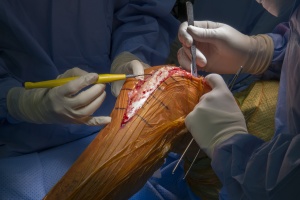October 27, 2018
Lessons about scaling peer-to-peer education — Mr James Murray on LinkedIn
I’m a member of the Smith and Nephew Visiting Surgeon Programme (VSP) and recently had the pleasure of hosting a visiting surgeon from Spain who was keen to learn more about revision knee replacement. It’s an excellent way to learn as a surgeon, and it got me thinking about the parallels between the VSP and OrthOracle, the online e-learning orthopaedic surgery platform, where I write procedural education.
1. Visualisation is key
The VSP is an international programme that brings together recognised experts with surgeons who would like to learn more. The visiting surgeon comes for one or two days, to learn from me or my colleague, Mr Andrew Porteous, who also performs a lot of revision knee replacement.
The direct visualisation of surgery is so critical to learning – it cannot be overstated. Surgical education must let the learner see the anatomy, the steps from set-up to post-op, and how the technique is the technique, every detail of the anatomy, as well as each detail of how things are done. The high-quality photographs on OrthOracle help recreate that scrubbed-in experience. This visual context helps the novice surgeon or one who is new to a procedure become more comfortable.
2. It’s in the details
In face-to-face learning, interaction is built in; a visiting surgeon will ask questions during the procedure, or we’ll sit down afterwards and discuss practicalities and technical tips for doing the case. As a platform, OrthOracle allows me to disseminate every detail of the workflow in a streamlined way.
I’m able to detail the order of the steps, the tricks I’ve learned that aren’t in manuals, and other pragmatic expertise. As an educator, it’s prompted me to start thinking of all the details that a learner might need, rather than waiting to be asked questions – which has made me a better, more thoughtful teacher overall.
3. Make it accessible across levels
On a course or peer to peer, the combination of didactic and interactive makes the dissemination of education more fluid, so it’s easier to tailor to the level of the participants. When creating educational modules for OrthOracle, I think it’s important to write for all levels.
Revision knee replacement, for example, is twice as long, twice as complicated, twice as expensive, to perform – which makes it stressful for everyone, from new surgeons to experienced surgeons who are fairly new to the procedure.
So my job becomes to not only provide the information needed to get started, but also to hone technique; for the CPD component, that means asking test questions that force the learner to think about what the evidence base means, not just what it says. (As an aside, here’s an educator-to-educator tip: write the questions at the same time as you’re writing the module, so that they work hand-in-hand!)
The OrthOracle platform really allows the modules to be different things for different people, and that’s the beauty of it. In terms of scaling procedure education, it’s the closest you can get to that in-person, peer-to-peer teaching. Look for my revision knee replacement modules, coming soon, or simply explore the Knee Atlas. And if you need to learn more about revision knee replacement then consider joining the Bristol Knee Revision Course next year.
Note: Originally posted on LinkedIn.


















